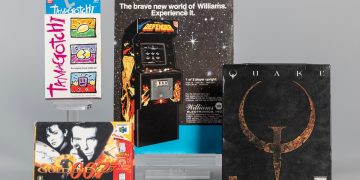Here’s what you need to know:
In recent news, Tencent, a powerhouse in the tech world, has announced the development of an intriguing new gaming handheld, the 3D One, in collaboration with Intel. This device is said to incorporate 3D screen technology, an Intel Lunar Lake processor, a hefty 32GB of RAM, and a 1TB SSD. It seems to borrow a page from the Nintendo Switch’s book with detachable controllers and boasts an impressive 11-inch display, which is even larger than Lenovo’s Legion Go. Currently, there’s no information on its potential release date or pricing.
In my opinion, the specs and features of this innovative gadget seem too extravagant to target mainstream consumers.
Yesterday, Tencent unveiled its intentions for this new gaming handheld, with Intel providing technical backing. Reports from IT Home, translated via Google, suggest that this is an experimental device incorporating “naked-eye 3D technology.”
A video shared by VideoCardz highlights the 3D One’s eye-tracking capabilities. In the video, a child is shown playing on the handheld without directly looking at the screen. This could imply a focus on 3D elements, or perhaps he’s checking out a linked TV screen. If the latter is true, it might work like a Nintendo Wii U, offering additional details on a larger display.
Delving into the 3D One’s specs, its price remains a mystery. However, it’s equipped with an Intel Core Ultra 7 358SV APU and Intel Arc 140V graphics. How this actually performs compared to the popular AMD Z1 Extreme found in other devices is still up in the air, though we might expect decent performance levels.
The sheer size of this gaming machine is noteworthy. Most PC gaming handhelds now, including the Steam Deck and ROG Ally, come with about a 7-inch display. Lenovo’s Legion Go has been the leader with an 8.8-inch screen, but the 3D One leaps ahead with an 11-inch 2.5K display, promising up to a 120Hz refresh rate. With dimensions this significant, calling it a “handheld” seems like a stretch. Its response time is still unknown.
For those interested in modular setups, the 3D One shares some similarities with the Legion Go with its detachable controllers and built-in kickstand. This feature could prove useful, especially given the hefty nature of the device. It also appears to have many connectivity options, including two USB-C ports, a USB-A port, a microSD slot, and a headphone jack. Another point of interest is the 2D/3D mode switch, reminiscent of the Nintendo 3DS, allowing users to toggle between viewing modes. A translation from the Chinese text on one image indicates it might feature Hall Effect joysticks for drift-free precision.
Now, if this device hits the market, it’s likely to come with a hefty price tag. Handheld gaming devices have gained considerable traction, but companies often need to make compromises to keep prices feasible. Even then, models like the ROG Ally retail for approximately $499.99, although discounts are occasionally available.
With its high-end specs and unique features, this Tencent and Intel collaboration might be too costly to appeal to a broad audience. There’s also the factor of 3D technology’s not-so-stellar history, as seen with the Nintendo 3DS. Although the concept was intriguing, many users turned off the 3D mode, and Nintendo even launched the 2DS to target younger audiences, as there were concerns about the impact of 3D on young eyes.
Having seen a handful of 3D monitors myself, the tech seems fascinating but not ready for mainstream adoption, often leading to headaches for users. Unless we see advancements like genuine holograms, the appeal might remain niche. Thus, the 3D One seems more like a showcase of Tencent’s capabilities rather than a product poised for mass-market success. Still, it remains to be seen if Tencent will surprise us with a launch.










![[PS5] Review of Lost Records: Bloom and Rage – Tape 2 [PS5] Review of Lost Records: Bloom and Rage – Tape 2](https://www.intergamerz.com/wp-content/uploads/2025/04/Complimentary-Game-Lost-Records-Bloom-and-Rage-PS5-Giveaway-North-360x180.jpg)






















![[Industry Direct] PHI Studio & Agog Invite Applications for a Four-Week Residency for Immersive Artists [Industry Direct] PHI Studio & Agog Invite Applications for a Four-Week Residency for Immersive Artists](https://www.intergamerz.com/wp-content/uploads/2025/05/Industry-Direct-PHI-Studio-Agog-Invite-Applications-for-a-360x180.jpg)












